Economics Report: US Cell Phone Market Dynamics and Projections
VerifiedAdded on 2023/04/22
|7
|1062
|104
Report
AI Summary
This economics report provides an analysis of the US cell phone market, examining the interplay of demand and supply factors. It discusses the increasing demand for smartphones, driven by factors like internet access and demographic trends, while also considering the supply side with key players such as Apple and Samsung. The report illustrates the impact of shifts in demand and supply on market equilibrium, using figures to demonstrate these effects. It further explores future projections, including potential market saturation and the need for manufacturers to adapt to changing consumer preferences by developing alternative devices. The report concludes by highlighting the dynamic nature of the cell phone market and its ongoing evolution. The report also includes references to relevant literature, supporting the analysis with academic research.
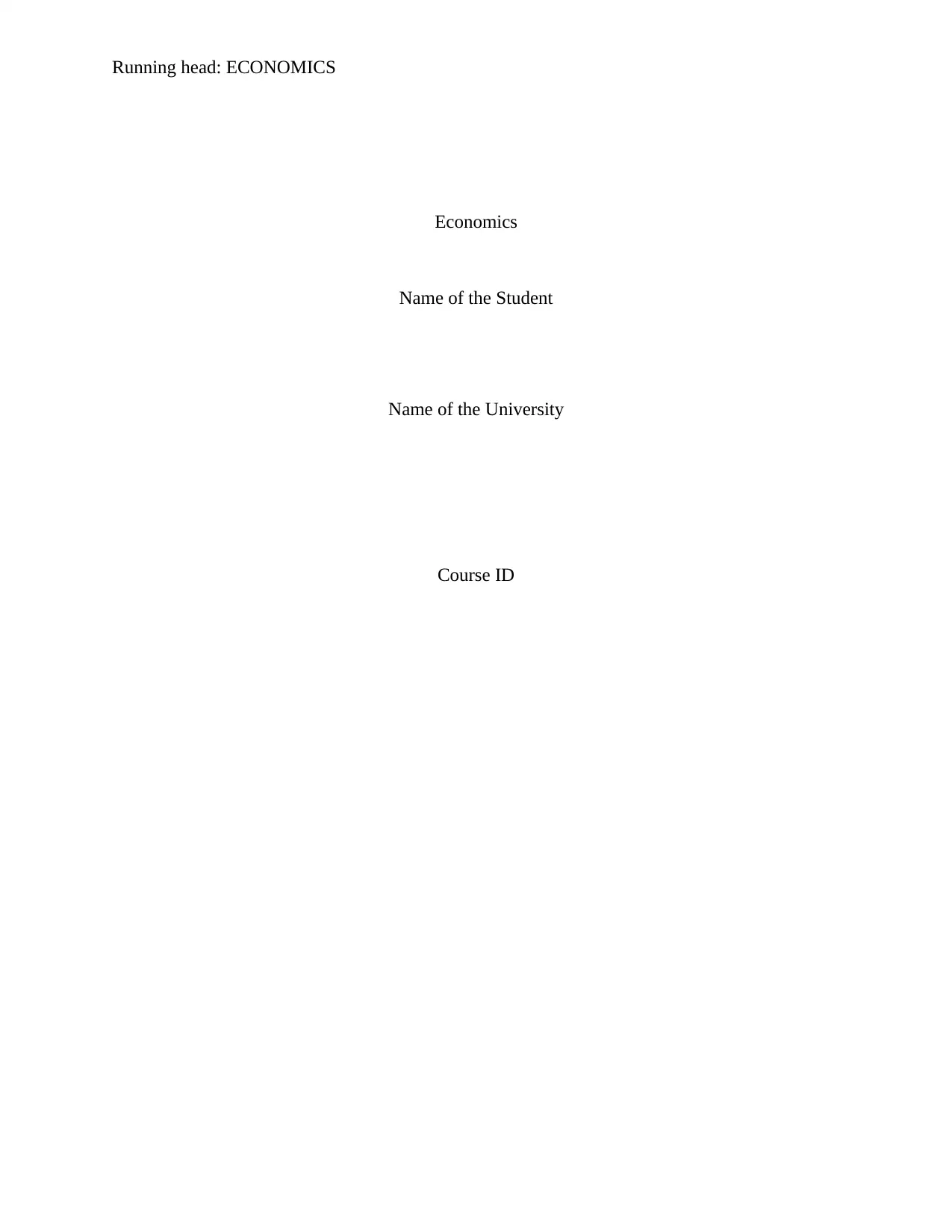
Running head: ECONOMICS
Economics
Name of the Student
Name of the University
Course ID
Economics
Name of the Student
Name of the University
Course ID
Paraphrase This Document
Need a fresh take? Get an instant paraphrase of this document with our AI Paraphraser
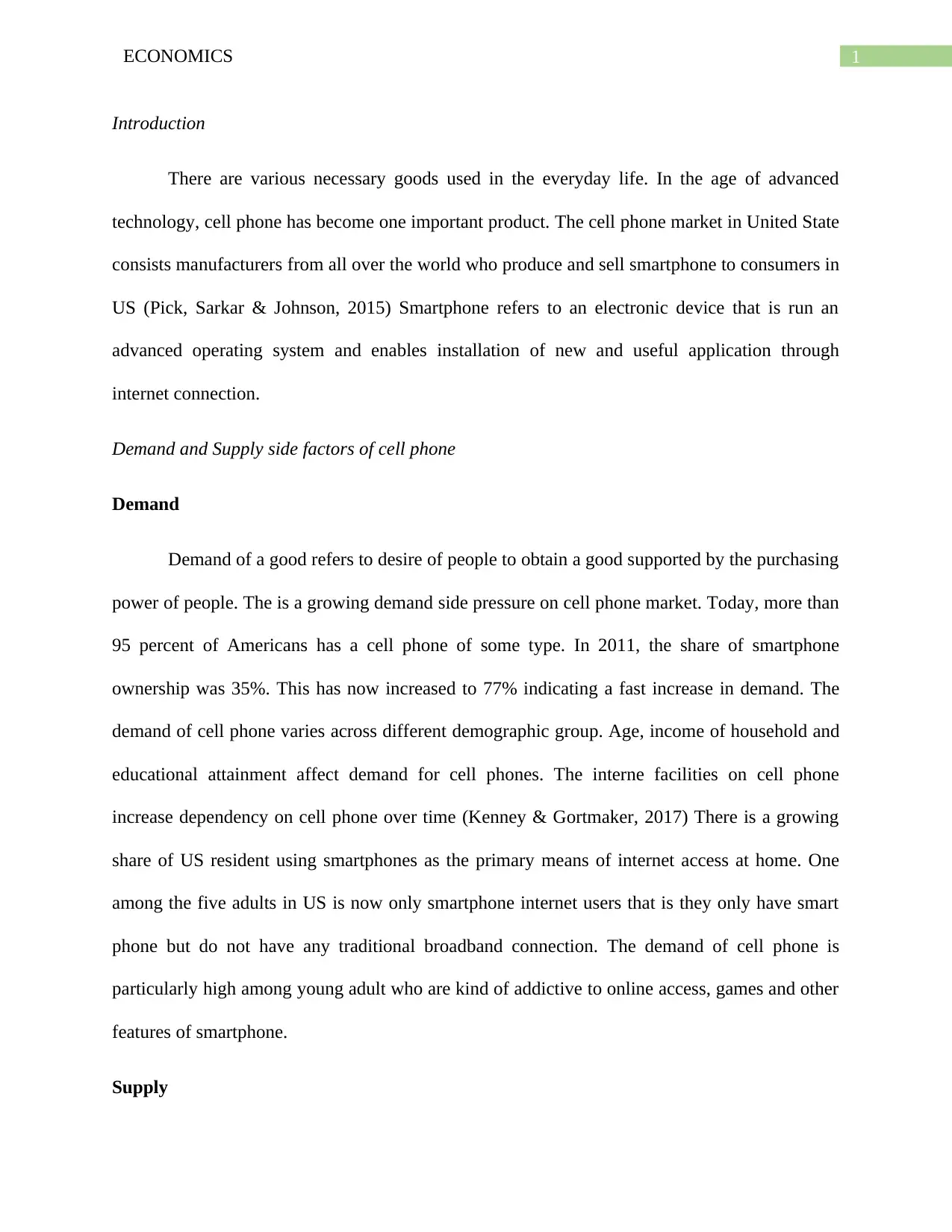
1ECONOMICS
Introduction
There are various necessary goods used in the everyday life. In the age of advanced
technology, cell phone has become one important product. The cell phone market in United State
consists manufacturers from all over the world who produce and sell smartphone to consumers in
US (Pick, Sarkar & Johnson, 2015) Smartphone refers to an electronic device that is run an
advanced operating system and enables installation of new and useful application through
internet connection.
Demand and Supply side factors of cell phone
Demand
Demand of a good refers to desire of people to obtain a good supported by the purchasing
power of people. The is a growing demand side pressure on cell phone market. Today, more than
95 percent of Americans has a cell phone of some type. In 2011, the share of smartphone
ownership was 35%. This has now increased to 77% indicating a fast increase in demand. The
demand of cell phone varies across different demographic group. Age, income of household and
educational attainment affect demand for cell phones. The interne facilities on cell phone
increase dependency on cell phone over time (Kenney & Gortmaker, 2017) There is a growing
share of US resident using smartphones as the primary means of internet access at home. One
among the five adults in US is now only smartphone internet users that is they only have smart
phone but do not have any traditional broadband connection. The demand of cell phone is
particularly high among young adult who are kind of addictive to online access, games and other
features of smartphone.
Supply
Introduction
There are various necessary goods used in the everyday life. In the age of advanced
technology, cell phone has become one important product. The cell phone market in United State
consists manufacturers from all over the world who produce and sell smartphone to consumers in
US (Pick, Sarkar & Johnson, 2015) Smartphone refers to an electronic device that is run an
advanced operating system and enables installation of new and useful application through
internet connection.
Demand and Supply side factors of cell phone
Demand
Demand of a good refers to desire of people to obtain a good supported by the purchasing
power of people. The is a growing demand side pressure on cell phone market. Today, more than
95 percent of Americans has a cell phone of some type. In 2011, the share of smartphone
ownership was 35%. This has now increased to 77% indicating a fast increase in demand. The
demand of cell phone varies across different demographic group. Age, income of household and
educational attainment affect demand for cell phones. The interne facilities on cell phone
increase dependency on cell phone over time (Kenney & Gortmaker, 2017) There is a growing
share of US resident using smartphones as the primary means of internet access at home. One
among the five adults in US is now only smartphone internet users that is they only have smart
phone but do not have any traditional broadband connection. The demand of cell phone is
particularly high among young adult who are kind of addictive to online access, games and other
features of smartphone.
Supply
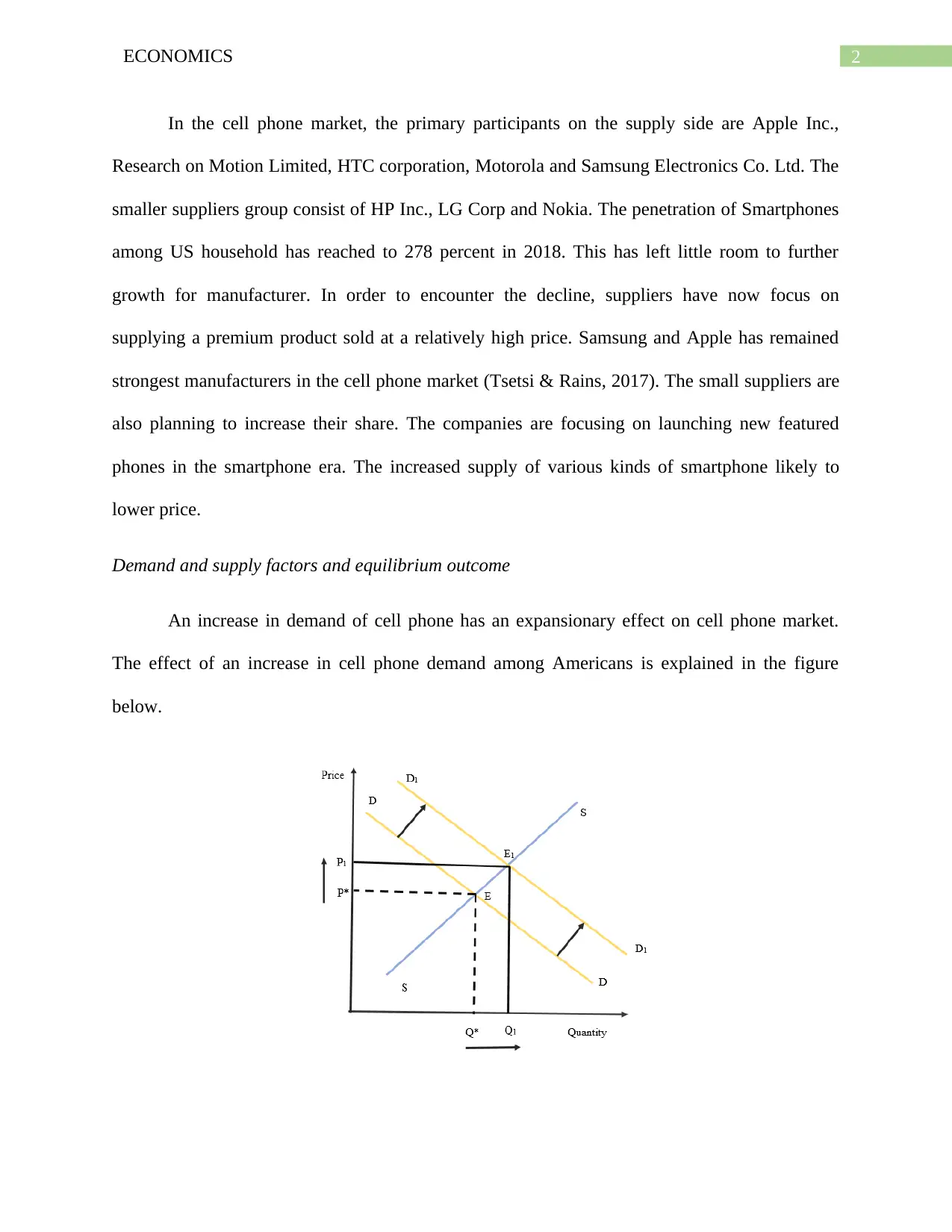
2ECONOMICS
In the cell phone market, the primary participants on the supply side are Apple Inc.,
Research on Motion Limited, HTC corporation, Motorola and Samsung Electronics Co. Ltd. The
smaller suppliers group consist of HP Inc., LG Corp and Nokia. The penetration of Smartphones
among US household has reached to 278 percent in 2018. This has left little room to further
growth for manufacturer. In order to encounter the decline, suppliers have now focus on
supplying a premium product sold at a relatively high price. Samsung and Apple has remained
strongest manufacturers in the cell phone market (Tsetsi & Rains, 2017). The small suppliers are
also planning to increase their share. The companies are focusing on launching new featured
phones in the smartphone era. The increased supply of various kinds of smartphone likely to
lower price.
Demand and supply factors and equilibrium outcome
An increase in demand of cell phone has an expansionary effect on cell phone market.
The effect of an increase in cell phone demand among Americans is explained in the figure
below.
In the cell phone market, the primary participants on the supply side are Apple Inc.,
Research on Motion Limited, HTC corporation, Motorola and Samsung Electronics Co. Ltd. The
smaller suppliers group consist of HP Inc., LG Corp and Nokia. The penetration of Smartphones
among US household has reached to 278 percent in 2018. This has left little room to further
growth for manufacturer. In order to encounter the decline, suppliers have now focus on
supplying a premium product sold at a relatively high price. Samsung and Apple has remained
strongest manufacturers in the cell phone market (Tsetsi & Rains, 2017). The small suppliers are
also planning to increase their share. The companies are focusing on launching new featured
phones in the smartphone era. The increased supply of various kinds of smartphone likely to
lower price.
Demand and supply factors and equilibrium outcome
An increase in demand of cell phone has an expansionary effect on cell phone market.
The effect of an increase in cell phone demand among Americans is explained in the figure
below.
⊘ This is a preview!⊘
Do you want full access?
Subscribe today to unlock all pages.

Trusted by 1+ million students worldwide
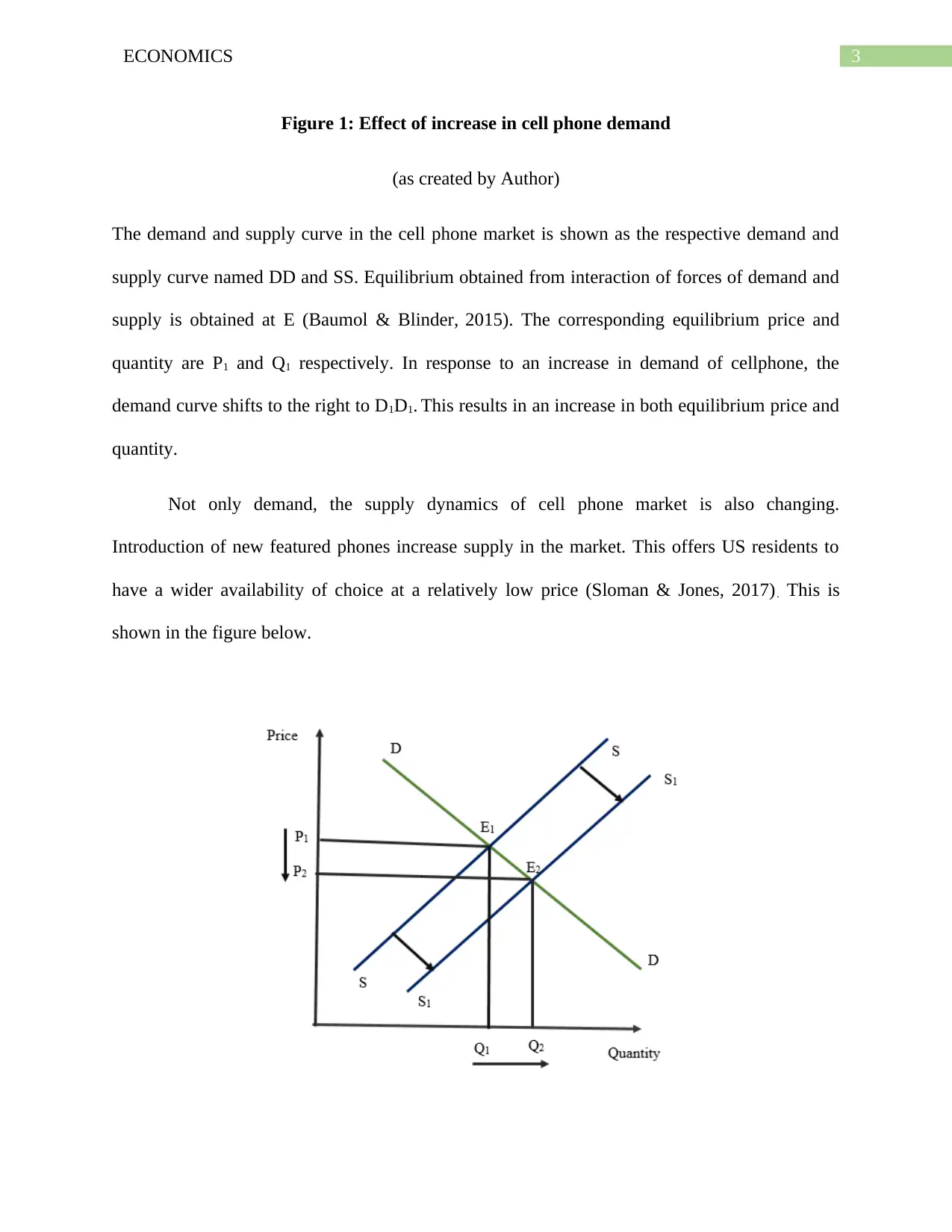
3ECONOMICS
Figure 1: Effect of increase in cell phone demand
(as created by Author)
The demand and supply curve in the cell phone market is shown as the respective demand and
supply curve named DD and SS. Equilibrium obtained from interaction of forces of demand and
supply is obtained at E (Baumol & Blinder, 2015). The corresponding equilibrium price and
quantity are P1 and Q1 respectively. In response to an increase in demand of cellphone, the
demand curve shifts to the right to D1D1. This results in an increase in both equilibrium price and
quantity.
Not only demand, the supply dynamics of cell phone market is also changing.
Introduction of new featured phones increase supply in the market. This offers US residents to
have a wider availability of choice at a relatively low price (Sloman & Jones, 2017). This is
shown in the figure below.
Figure 1: Effect of increase in cell phone demand
(as created by Author)
The demand and supply curve in the cell phone market is shown as the respective demand and
supply curve named DD and SS. Equilibrium obtained from interaction of forces of demand and
supply is obtained at E (Baumol & Blinder, 2015). The corresponding equilibrium price and
quantity are P1 and Q1 respectively. In response to an increase in demand of cellphone, the
demand curve shifts to the right to D1D1. This results in an increase in both equilibrium price and
quantity.
Not only demand, the supply dynamics of cell phone market is also changing.
Introduction of new featured phones increase supply in the market. This offers US residents to
have a wider availability of choice at a relatively low price (Sloman & Jones, 2017). This is
shown in the figure below.
Paraphrase This Document
Need a fresh take? Get an instant paraphrase of this document with our AI Paraphraser

4ECONOMICS
Figure 2: Effect of increase in cell phone supply
(as created by Author
Figure 2: Effect of increase in cell phone supply
(as created by Author
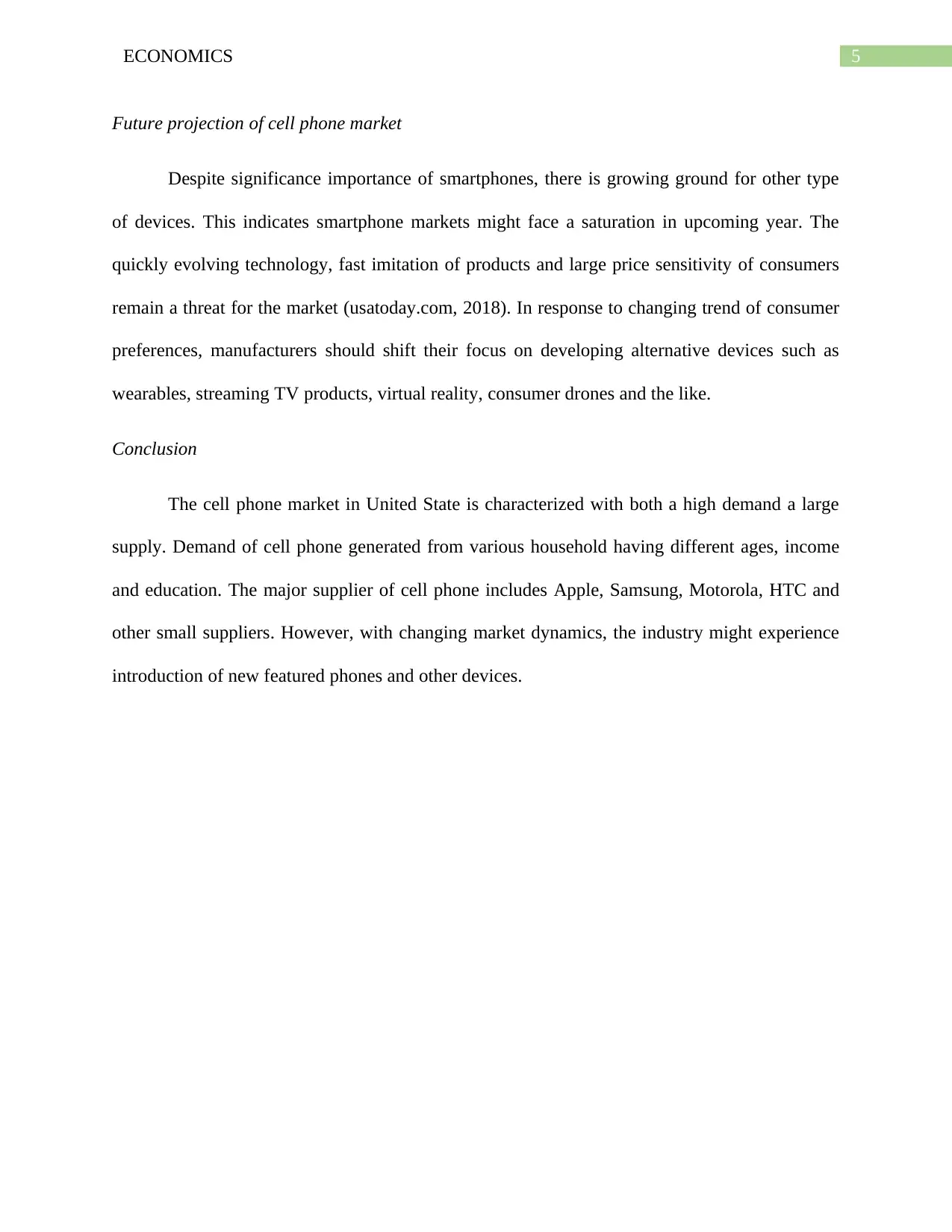
5ECONOMICS
Future projection of cell phone market
Despite significance importance of smartphones, there is growing ground for other type
of devices. This indicates smartphone markets might face a saturation in upcoming year. The
quickly evolving technology, fast imitation of products and large price sensitivity of consumers
remain a threat for the market (usatoday.com, 2018). In response to changing trend of consumer
preferences, manufacturers should shift their focus on developing alternative devices such as
wearables, streaming TV products, virtual reality, consumer drones and the like.
Conclusion
The cell phone market in United State is characterized with both a high demand a large
supply. Demand of cell phone generated from various household having different ages, income
and education. The major supplier of cell phone includes Apple, Samsung, Motorola, HTC and
other small suppliers. However, with changing market dynamics, the industry might experience
introduction of new featured phones and other devices.
Future projection of cell phone market
Despite significance importance of smartphones, there is growing ground for other type
of devices. This indicates smartphone markets might face a saturation in upcoming year. The
quickly evolving technology, fast imitation of products and large price sensitivity of consumers
remain a threat for the market (usatoday.com, 2018). In response to changing trend of consumer
preferences, manufacturers should shift their focus on developing alternative devices such as
wearables, streaming TV products, virtual reality, consumer drones and the like.
Conclusion
The cell phone market in United State is characterized with both a high demand a large
supply. Demand of cell phone generated from various household having different ages, income
and education. The major supplier of cell phone includes Apple, Samsung, Motorola, HTC and
other small suppliers. However, with changing market dynamics, the industry might experience
introduction of new featured phones and other devices.
⊘ This is a preview!⊘
Do you want full access?
Subscribe today to unlock all pages.

Trusted by 1+ million students worldwide
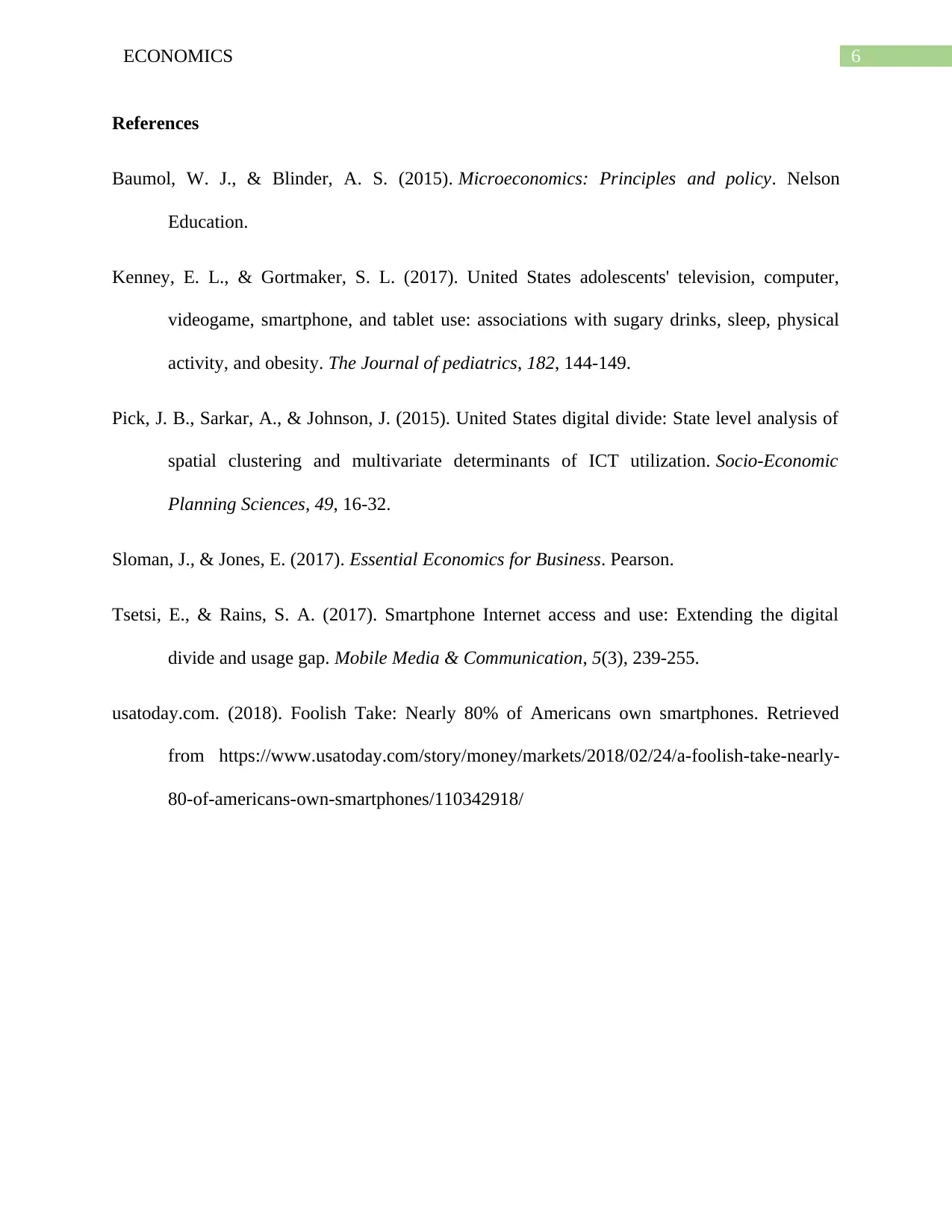
6ECONOMICS
References
Baumol, W. J., & Blinder, A. S. (2015). Microeconomics: Principles and policy. Nelson
Education.
Kenney, E. L., & Gortmaker, S. L. (2017). United States adolescents' television, computer,
videogame, smartphone, and tablet use: associations with sugary drinks, sleep, physical
activity, and obesity. The Journal of pediatrics, 182, 144-149.
Pick, J. B., Sarkar, A., & Johnson, J. (2015). United States digital divide: State level analysis of
spatial clustering and multivariate determinants of ICT utilization. Socio-Economic
Planning Sciences, 49, 16-32.
Sloman, J., & Jones, E. (2017). Essential Economics for Business. Pearson.
Tsetsi, E., & Rains, S. A. (2017). Smartphone Internet access and use: Extending the digital
divide and usage gap. Mobile Media & Communication, 5(3), 239-255.
usatoday.com. (2018). Foolish Take: Nearly 80% of Americans own smartphones. Retrieved
from https://www.usatoday.com/story/money/markets/2018/02/24/a-foolish-take-nearly-
80-of-americans-own-smartphones/110342918/
References
Baumol, W. J., & Blinder, A. S. (2015). Microeconomics: Principles and policy. Nelson
Education.
Kenney, E. L., & Gortmaker, S. L. (2017). United States adolescents' television, computer,
videogame, smartphone, and tablet use: associations with sugary drinks, sleep, physical
activity, and obesity. The Journal of pediatrics, 182, 144-149.
Pick, J. B., Sarkar, A., & Johnson, J. (2015). United States digital divide: State level analysis of
spatial clustering and multivariate determinants of ICT utilization. Socio-Economic
Planning Sciences, 49, 16-32.
Sloman, J., & Jones, E. (2017). Essential Economics for Business. Pearson.
Tsetsi, E., & Rains, S. A. (2017). Smartphone Internet access and use: Extending the digital
divide and usage gap. Mobile Media & Communication, 5(3), 239-255.
usatoday.com. (2018). Foolish Take: Nearly 80% of Americans own smartphones. Retrieved
from https://www.usatoday.com/story/money/markets/2018/02/24/a-foolish-take-nearly-
80-of-americans-own-smartphones/110342918/
1 out of 7
Related Documents
Your All-in-One AI-Powered Toolkit for Academic Success.
+13062052269
info@desklib.com
Available 24*7 on WhatsApp / Email
![[object Object]](/_next/static/media/star-bottom.7253800d.svg)
Unlock your academic potential
Copyright © 2020–2025 A2Z Services. All Rights Reserved. Developed and managed by ZUCOL.





